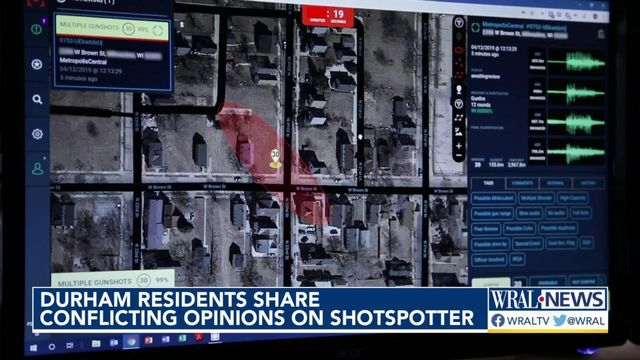Controversial ShotSpotter technology to be used by police along 3 square miles in east, south Durham
The ShotSpotter technology is intended to help the city identify and deploy police to an area where gunshots were heard -- even if no 911 call was placed.
Posted — UpdatedThe new technology will monitor three square miles of Durham, including parts of Bowen Street, North Carolina Highway 55 and North Alston Boulevard. Unlike other forms of police surveillance, ShotSpotter only uses audio to detect gunshots.
Residents who live in the area covered by the ShotSpotter are just as divided as the rest of the city on whether or not the technology is worth it.
Natalie Spring has lived in the Cleveland Holloway neighborhood for 20 years. She and others on her street are against ShotSpotter being used in their neighborhood.
"Today, when we found out we were going to be one of the neighborhoods, it’s very surprising," Spring said. "They’re overpromising, and they’re going to under deliver. I know that what they promise in their marketing materials is not possible with the technology they have."
Debate over accuracy of ShotSpotter technology
Spring is a data scientist and she claims to have researched the technology.
"I actually am more afraid that because the technology is so bad, it’s going to send armed police officers in thinking there’s violence when there’s kids playing fireworks in the summer," Spring said. "I just don’t think that what they have to offer is going to help us. I want a solution to the gun violence in Durham."
"[From 2019 to 2021] across all clients, our audit confirmed that based on client reports, ShotSpotter correctly detected, classified, and published gunfire with 97.69% accuracy, which is slightly higher than the 2019 and 2020 accuracy rate of 97.59%," the audit said.
Durham residents: It doesn't stop with ShotSpotter
Durham residents believe there could be a net benefit to the technology.
Keaton believes the ShotSpotter could have a tangible impact on the community's gun violence problem.
"I really think it can help, help our community, and help us come back together," he said.
Charlitta Burrus lives on the east side of the technology’s coverage area.
"In my area there is gunshots frequently," Burrus said. "I don’t really have a problem with it coming to our area."
She’s accepting of the program, but doesn’t think addressing gun violence should stop there.
"We’ve got to continue to communicate and work together. 911, police department, sheriff’s department. Everyone needs to be in the loop on what exactly is going on," Burrus said.
"If they could put it all around the city, periodically move the ShotSpotter technology from one neighborhood to another, and possibly cover all of Durham," she added, "Because right now, Durham is not exempt nowhere from gunshots and gunfire."
NCCU chancellor hopeful for change
The southern border of the coverage area touches North Carolina Central University’s campus.
Chancellor Johnson Akinleye asked the city years ago to deploy ShotSpotter technology near campus.
"I’m very grateful to the city for finally implementing, or at least approving the budget for that," Akinleye said. "I believe trying to do everything we can do prevent crime is something that we must do."
"On our campus we’ve invested quite a bit in enhanced security," Akinleye said. "But, I also think ShotSpotter is another layer that will help not just NCCU, but the surrounding community."
Related Topics
• Credits
Copyright 2024 by Capitol Broadcasting Company. All rights reserved. This material may not be published, broadcast, rewritten or redistributed.





